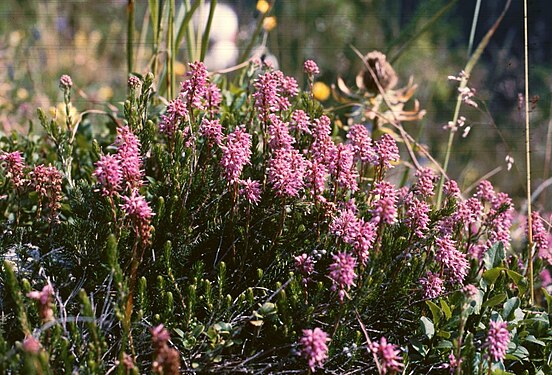Erica spiculifolia
| Habit | shrub
| |
|---|---|---|
| Lifespan: | ⌛ | perennial |
| Bloom: | ❀ | early summer |
| Features: | ✓ | evergreen, flowers |
|---|---|---|
| Flower features: | ❀ | red, pink |
Bruckenthalia This genus consists of only one species, an evergreen shrub native to southeastern Europe and Asia Minor. It is a dwarf and heath-like plant to 10 in high. Suitable for rock gardens and borders. Leaves are dark green. The flowers in terminal clusters of rose-pink, bell-shaped appear in early summer.
Read about Erica spiculifolia in the Standard Cyclopedia of Horticulture
|
|---|
|
Bruckenthalia (after S. von Bruckenthal, an Austrian nobleman). Ericaceae. Ornamental shrub, chiefly grown for its profusely produced small spikes of pink flowers. Leaves linear, whorled: fls. in short racemes; calyx campanulate, 4-lobed; corolla campanulate with 4triangular lobes; stamens 8, included, connate at the base; disk rudimentary; caps, sub- globose, 4-celled, loculicid, many- seeded. — One species in S. E. Eu. and Asia Minor. Very closely related to Erica, but differs chiefly in the calyx being lobed only to the middle, not 4- parted, in the rudimentary disk and the connate stamens. This is a low evergreen, heath- like shrub forming large tufts, with needle-shaped small leaves and small rosy pink nodding flowers in short terminal racemes, produced in great profusion. Perfectly hardy North and requiring the same treatment as hardy ericas; a pretty little plant for rockeries. Propagation is usually by seeds which are freely produced in cultivation and treated like-those of erica; also by cuttings.
|
Cultivation
The plant prefers sandy peat with lime-free.
Propagation
Propagate from seed, cuttings or division.
Pests and diseases
- Do you have pest and disease info on this plant? Edit this section!
Species
Gallery
If you have a photo of this plant, please upload it! Plus, there may be other photos available for you to add.
References
External links
- w:Erica spiculifolia. Some of the material on this page may be from Wikipedia, under the Creative Commons license.
- Erica spiculifolia QR Code (Size 50, 100, 200, 500)





